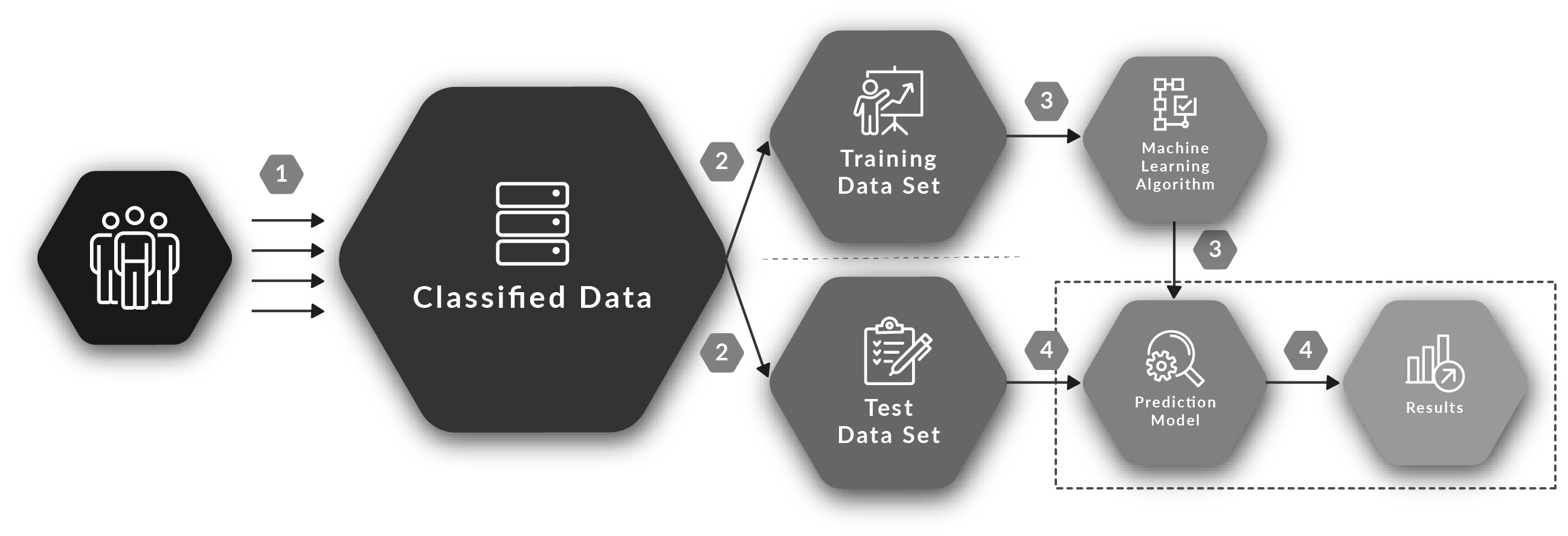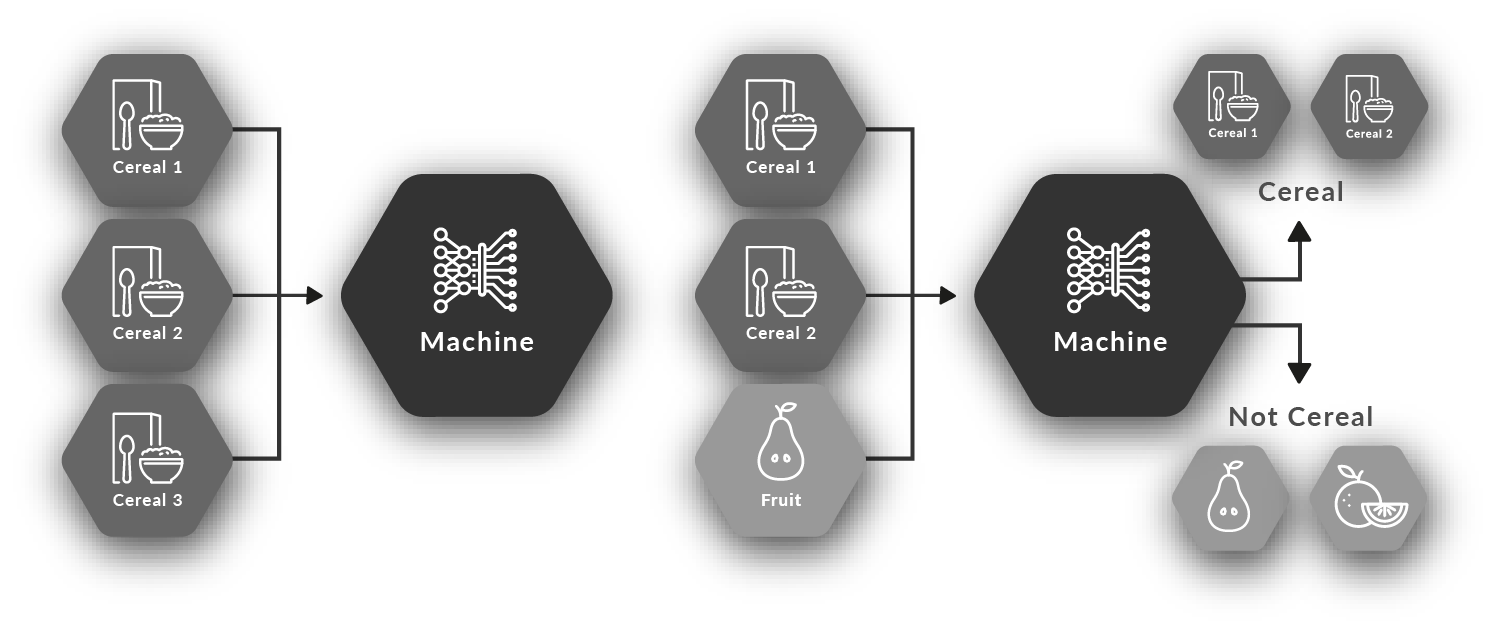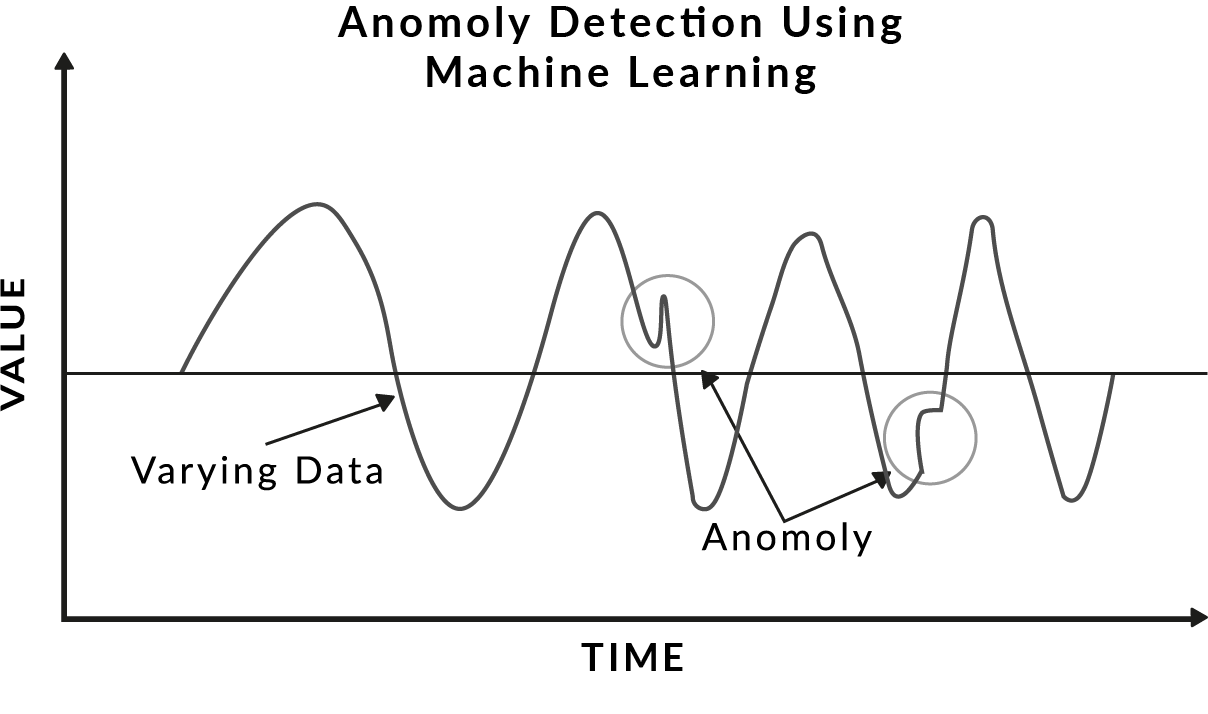Machine learning and artificial intelligence are among the top talked about terms in business today. You’re likely to find that industry leaders have used the first-mover advantage to implement these functions in their business and sustain a competitive advantage.
What is machine learning?
Machine learning is an application of artificial intelligence used as a tool to turn information into knowledge. You’d use this practice to analyse, understand and find patterns in a data set that would not easily be identified manually.
But first, we must make the distinction between software engineering and machine learning.
Software engineering works by humans providing rules along with data to create the solution to a problem. On the other hand, machine learning uses the available data and answers to the problem to create the rules itself. Once you have provided the examples, your computer system tests out different variations of rules to learn, which provides the most accurate answer without being explicitly programmed. The system uses this information to understand the data, detect patterns and make improved decisions based on the examples you provide.
Machine learning allows computers to learn and function automatically without human assistance, creating more efficient and effective processes. You can use machine learning to create solutions based on data drivers within your business and make predictions that will help you to make complex decisions.
Although machine learning can seem like a complex concept, you interact with it every day. Every time you use an online search engine, interact on social media or order a product online, the system is learning your purchasing patterns and making recommendations based on what you like and buy.
There are different types of machine learning, namely supervised learning, unsupervised learning, semi-supervised learning and reinforcement learning.

What is supervised machine learning?
When you use supervised learning techniques, you will need a fully labelled/classified data set to train the algorithm. Both the input variables and the output variables are known. For example, the input variable may be product price while the output value may be units movement.
When you use supervised machine learning, you can apply the information you gathered in the past to new data using labelled examples to predict the answers. Once you’ve given the system a training data set, the learning algorithm can produce an inferred function which it uses to make predictions about the answers you require. The algorithm can also compare its answer with the correct response you provided in the training data set and adapt the model to be more accurate.
Supervised machine learning helps you to solve various types of real-world computation problems.
For example, if you were to use a shopper basket datasheet and would like to classify each product based on budget, mid-market or premium brands, you could train the algorithm on a data set that you have already classified.
As you can see in the image below, we’ve used the algorithm to label or categorise the input data into output data. For this example, you can see that we’ve analysed and labeled different types of food products as either breakfast cereal or not breakfast cereal. You could also go into more depth, classifying breakfast cereals by flavour or colour, depending on what you want to know.

Supervised machine learning makes use of two techniques, namely classification and regression.
Classification problems require the algorithm to predict a discrete value, identifying the input data as belonging to a specific category or group. You could use this technique to classify products by department, category, subcategory or even segment.
You’d use machine learning to set rules to linearly separate values. This means that classification uses a line/decision boundary in the data set to separate items and classify them.
Regression analysis requires the algorithm to work with continuous data. You can use this technique to predict the switching behaviour and average spend of consumers once they have switched to your brand.
Unlike classification that outputs a categorisation, regression analysis outputs a number which is useful for predictions of prices, sales and probability of events.

What is unsupervised machine learning?
Unsupervised machine learning uses data that is not classified, categorised or labelled. Although it does not aim to produce specific outputs, the algorithm can analyse and detect similarities within the data set as well as make predictions. Unsupervised machine learning allows you to perform more complex analyses than when using supervised learning.
However, these models may be more unpredictable than supervised methods. You may not be able to retrieve precise information when sorting data as the output of the process is unknown. When you use an unsupervised technique, you will also need to spend time interpreting the results and drawing meaningful information that you can use in your business.
When using unsupervised machine learning, you would use a data set as the input for the algorithm. You could then arrange or present the results of the analysis in various formats:
You can use cluster analysis to detect similarities between data points and group them accordingly. When clustering a product category, you can choose the variables that are most important to your business such as brand, subcategory or demographics.

You can use anomaly detection to detect abnormalities in a data set. This is an important technique that you can use for a variety of business needs.
For example, as an online retailer, you can use this to detect irregular or fraudulent transactions when the same credit card is used in two different countries on the same day.
Retailers can also use anomaly detection to discover unusual customer purchasing patterns. Retailers with many store branches are able to detect when a customer is on holiday in another part of the country when they shop at a different branch. Ultimately this type of algorithm notifies the user of outliers in the data set that might need to be brought to their attention and addressed. This type of algorithm works in real-time and may save your business money and time.
Association techniques provide rules to describe your data set.
For example, if your customer buys product A they are likely to buy product B. You can use this technique to assess shopper basket data to provide recommendations to customers with regards to product bundling. You can also use demographic information to compare purchased products to create shopper profiles to understand and target a target market more effectively.
You can use auto encoders to compress input data into code and recreate it. This technique is best used for product cloning. In data analysis, product cloning is where you add a new product to a store and then want to understand how it is likely to perform. That’s where you would use a product clone to predict its behaviour and make data-driven decisions. DotActiv uses product cloning in its range optimizer.

Where does semi-supervised machine learning come in?
Semi-supervised machine learning uses a combination of supervised and unsupervised approaches to process data.
To use this approach, you would make use of both classified and unclassified data to train the algorithm. The learning process, therefore, is not as supervised with all inputs and outputs provided but also is not allowed to learn completely independently.
You would typically use this approach when you have a small amount of classified data and a large amount of unclassified data to improve the accuracy of model learning and predictions. You may not have enough classified data to create an accurate model and need to use semi-supervised learning to increase the size of your training data and produce a more accurate result. Businesses may use this technique for applications like web page classification or speech recognition.
A technique used within semi-supervised machine learning is called a Generative Adversarial Network (GAN). A GAN uses two neural networks called a generator and a discriminator to produce accurate results. The generator produces the output and the discriminator evaluates it to improve the overall accuracy of the algorithm without requiring specific data labels each time.
What about reinforcement learning?
Reinforcement learning is a fairly new and complex type of machine learning. The system aims to deliver the best result at the lowest energy cost to the system. The lower the energy cost, the higher the reward. A reinforcement machine learning algorithm interacts with the data set to produce actions and discover either an error or a reward based on trial and error.
This method allows your system to automatically identify the ideal behaviour to maximise its performance and optimise the reward.
Which approach is right for your business?
No matter if you’re an online or brick and mortar retailer, you can use machine learning. Below are some examples that might help you decide how to best use this practice in your retail business to reduce costs and generate a return on investment.
1. Predicting stock management
If you’re a brick and mortar retailer, you can use unsupervised machine learning techniques to analyse shopper data to predict stock movement and inventory requirements in real-time.
Your buyers can use this information, which is based on factors such as day of the week, season, holiday and past customer behaviour to inform product choices and order quantities.
This application requires access to POS and shopper data as well as external market data and will lead to an overall increase in business revenue.
2. Analysing shopper in-store behaviour
You can analyse the in-store behaviour of shoppers to understand their path to purchase and decision-making process. You can also run machine learning algorithms using information gathered from your in-store cameras. This will help you to track the movement of shoppers through your store. You can use this information to organise floor and shelf plans to attract the attention of your customers.
3. Theft prevention
As a brick and mortar retailer, you will see a direct reduction in costs and an increase in ROI when using machine learning for theft prevention. This application can use facial recognition to detect previously identified shoplifters as well as identify whether a shopper picks and conceals an item.
This technology can also detect whether tellers fail to scan each item when checking a customer out, either by accident or on purpose. You can also use it to alert security staff to a problem which you can evaluate before confronting the shopper.
4. Eye trackers and facial expression monitoring
You can use eye-tracking technology to increase revenue and understand the behaviour of their target market while they are in your store. A machine learning algorithm can analyse facial expression to assess how consumers feel about specific products. Meanwhile, eye trackers can assess which product attributes shoppers prioritise based on how long they evaluate these characteristics.
This information can further be used for product-attribute clustering. You can implement this technology into your store by using advanced cameras and software programmes.
5. Virtual mirrors
Clothing and cosmetics stores can make use of virtual mirrors to elevate their customer’s in-store experience and likelihood to purchase. Virtual mirrors will allow your customers to virtually try products as well as receive recommendations based on what they like. This application will lead to a reduction in costs and an increase in revenue for your business.
6. In-store assistants
You can use machine learning by installing in-store assistants similar to the interactive boards found in malls. The assistant could tell customers where to find a particular product in the store or recommend products based on their needs. In-store assistants benefit customers by providing an efficient personalised shopping experience, thereby increasing their loyalty to the brand.
You could also generate shopper data from the inputs used in the assistant. To create an in-store assistant, you will need information about your products, inventory levels and customers which you can retrieve from your POS and loyalty data. This application will lead to a reduction in costs and an increase in revenue for your business.
7. Product recommendations
If you’re an online retailer, you can use shopper insights to boost sales using recommendation engines. This application enhances the customer’s shopping experience through personalised offers which speed up their time on the site and allow them to easily find what they are looking for.
You can retain more of your customer base by interacting with them in a tailored manner, enhancing their experience and encouraging impulse purchases. If you would like to use a recommendation engine for your online store, you will need access to shopper data in terms of purchases, search history and site navigation information. You will also need product information in the form of POS data, product images and descriptions.
8. Pricing prediction and strategy
Your pricing strategy is directly linked to the profitability of your company. You can use machine learning to consider important variables influencing your product selling prices to create a dynamic pricing strategy that operates in real-time. The algorithm you select can search the internet for prices of similar products. Historical sales data, seasonality, competition and promotional prices should also be considered at this point.
If you would like to use machine learning to optimise your pricing strategy, you will need access to shopper data in terms of purchases, search history and site navigational data. You will need competitor data with reference to their brands and website information. You will also need external market data as well as product POS data.
9. Customer behaviour prediction
You can use machine learning to analyse the behaviour of your target market to predict future behaviour. This application will allow you to segment and profile your consumers as well as provide a personalised marketing and shopping experience to ultimately enhance their loyalty. If you would like to predict your shopper’s behaviour you will need access to POS and loyalty data.
10. Social media management
You can also use machine learning to monitor activity on your social media platforms. Consumers are starting to use these facilities as a virtual marketplace that can provide you with information about engagement, traffic and overall feelings about your brand and its products. You can use the insights generated from this application to optimise the sales channel, content and timing of marketing activities to generate the best return on investment.
You can also analyse competitor behaviour. If you would like to implement social media management, you will need access to external market data and competitor information.
11. Chatbots
Lastly, you can use chatbots to interact with your online customers in real-time. The time to live or expected waiting period before a response is received for online platforms is only minutes long. Chatbots can interact with your customers, answering questions, providing recommendations and handling customer service concerns that would otherwise be time-consuming to handle manually.
Conclusion
When you evaluate the various applications of machine learning, it is not always easy to choose which solutions would be the most feasible and effective for your business. The technique that you choose will depend on your business’ goals and objectives, availability of resources and access to data.
Looking for assistance when choosing between supervised and unsupervised machine learning? Let DotActiv help. Find out more about our cluster optimization service or book a complimentary meeting with a DotActiv expert.


